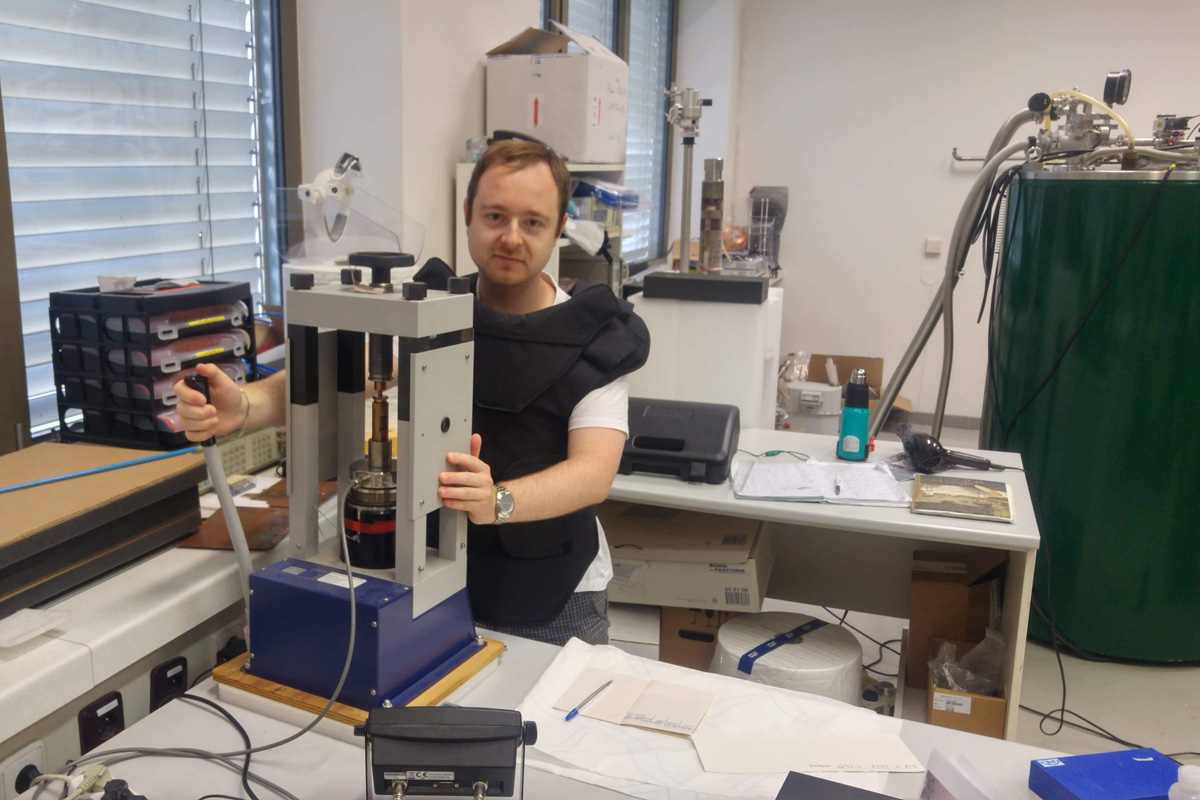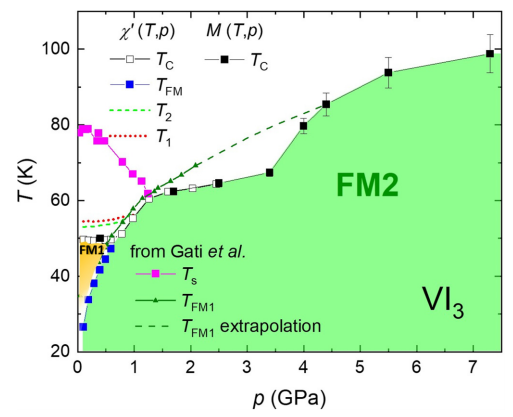
The ferromagnetic compound VI3 has been already investigated in the MGML laboratories [1] as a member of a family of quasi-two-dimensional (2D) van der Waals materials showing promising application potential for the design of spintronic devices.
As a next research step of this unique system, we have focused on the evolution of its magnetism in external pressure up to 7.3 GPa studied by measuring magnetization and ac magnetic susceptibility [2] . Four magnetic phase transitions, at T1 = 54.5 K, T2 = 53 K, TC = 49.5 K, and TFM = 26 K, respectively, have been observed at ambient pressure. The first two have been attributed to the onset of ferromagnetism in specific crystal-surface layers. The bulk ferromagnetism is characterized by the magnetic ordering transition at Curie temperature TC and the transition between two different ferromagnetic phases TFM, accompanied by a structure transition from monoclinic to triclinic symmetry upon cooling. TC was found to be almost unaffected by pressures up to 0.6 GPa whereas TFM increases rapidly with increasing pressure and reaches TC at a triple point at ≈ 0.85 GPa. At higher pressures, only one magnetic phase transition is observed moving to higher temperatures with increasing pressure to reach 99 K at 7.3 GPa. In contrast, the low-temperature bulk magnetization is significantly reduced by applying pressure (by more than 50% at 2.5 GPa) suggesting a possible pressure-induced reduction of vanadium magnetic moment. First-principles calculations of VI3 under pressure allow us to ascribe the evolution of TC with pressure to the reduction of interplanar distance, including the observed slope change at 0.6 GPa. These calculations also describe the associated band gap closing, showing that with a modest compression the material would become metallic. Overall, the large pressure range covered corresponds to a significant change of interplanar interactions.
The obtained data thus allowed us to shed light on how the transition between the three-dimensional and quasi-2D system affects magnetic interactions in the system.
A thorough single-crystal study of crystal structure and microscopic aspects of magnetism by x-ray and neutron diffraction under pressure is needed to resolve the mechanism responsible for the findings presented in this study. Therefore, extensive investigations of the VI3 magnetism are ongoing in MGML as illustrated by a recently accepted manuscript [4] .
Fig. 1: Temperature-pressure magnetic phase diagram of VI3 derived from results of the ac and DC magnetic susceptibility magnetization measurements measured with a sample in a piston-cylinder and DAC pressure cell, respectively. Details can be found in the text and Ref. [2,3].
[1] P. Doležal, M. Kratochvílová, V. Holý, P. Čermák, V. Sechovský, M. Dušek, M. Míšek, T. Chakraborty, Y. Noda, S. Son, and J. Park, Physical Review Materials 3, 121401(R) (2019). DOI: https://doi.org/10.1103/PhysRevMaterials.3.121401
[2] J. Valenta, M. Kratochvílová, M. Míšek, K. Carva, J. Kaštil, P. Doležal, P. Opletal, P. Čermák, P. Proschek, K. Uhlířová, J. Prchal, M. J. Coak, S. Son, J-G. Park, and V. Sechovský, Physical Review B 103 (2021) 054424. DOI: https://doi.org/10.1103/PhysRevB.103.054424
[3] E. Gati, Y. Inagaki, T. Kong, R. J. Cava, Y. Furukawa, P. C. Canfield, and S. L. Bud’ko, Physical Review B 100, 094408 (2019). DOI: https://doi.org/10.1103/PhysRevB.100.094408
[4] A. Koriki, M. Míšek, J. Pospíšil, M. Kratochvílová, K. Carva, J. Prokleška, P. Doležal, J. Kaštil, S. Son, J-G. Park, and V. Sechovský, Magnetic anisotropy in the van der Waals ferromagnet VI3, accepted in Physical Review B (2021). See arXiv:2101.03542.

